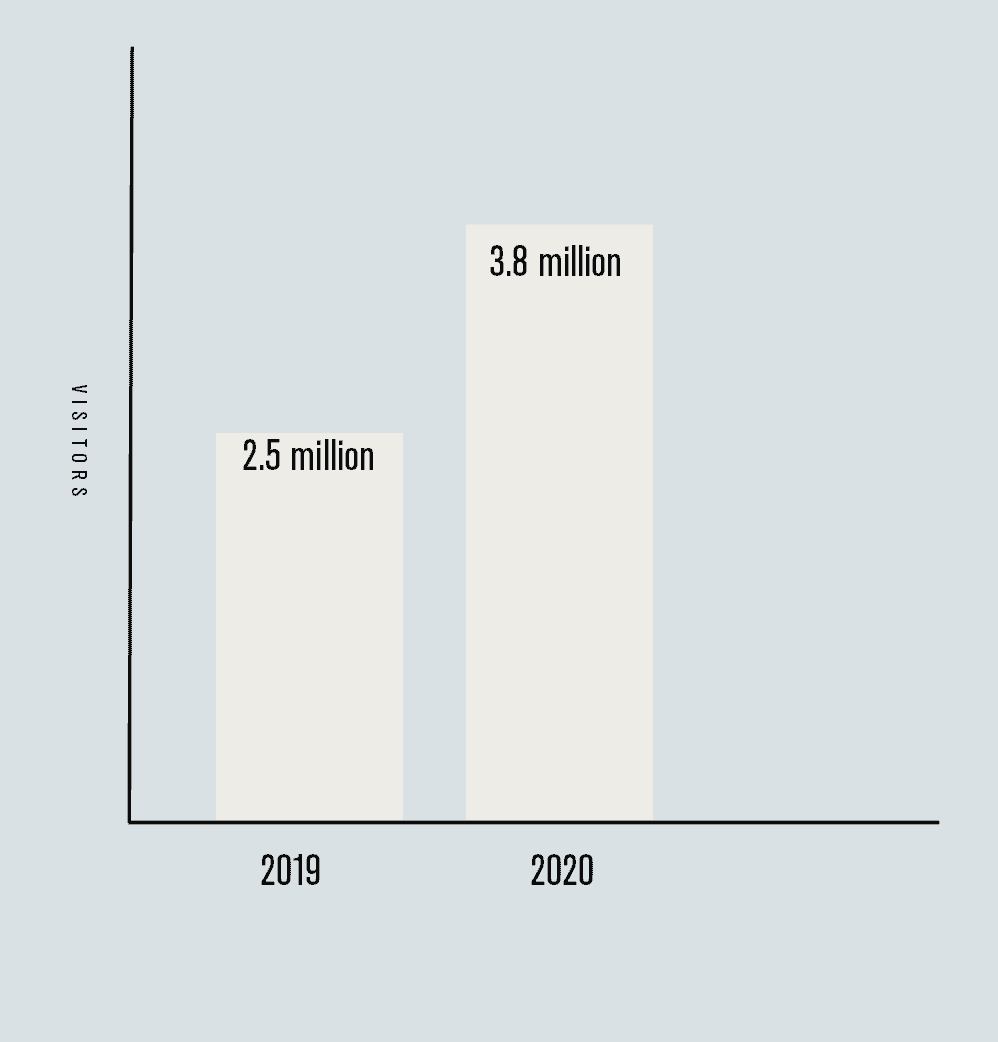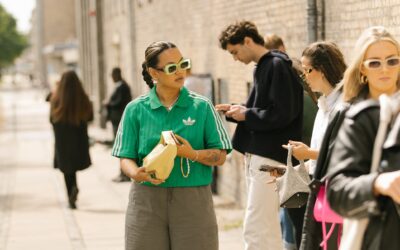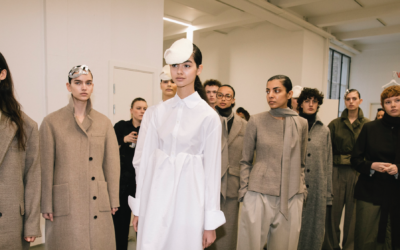A year in retrospect: VOCAST’s 2020 key learnings
It comes as no surprise that “Coronavirus” was the most googled word of the year. With daily and even hourly updates from every possible platform being the norm, every newspaper and media outlet offered information to keep us up to date. We too have not been an exception. At VOCAST we checked in with our markets regularly to be able to provide you with a monthly COVID-19 update, in which we displayed an overview of insights.
In the following VOCAST’s 2020 key learnings, we will be looking into the past year, what consumer and influencer change the year brought, the way experiencing fashion weeks and fairs will be changed forever, in what way press and publishing have dealt with the pandemic and in what way VOCAST has aided in brand digitalization and visibility this year. We underwent an in-house analysis and want to share our full review and platform success cases of the year with you.
Lifestyle in 2020: Comfort & Practicality
Fashion trends:
40% of European consumers are reported to have spent less money on clothing for different reasons. In general, consumers have been less inclined to purchase clothing as they prioritize other necessities under financial stress. But it is not only economic issues causing the radical shift in consumers’ spending habits.
Staying at home a lot has simply come to imply different and less expensive clothing habits. This has also meant a shift in the parameter which consumers consider when purchasing clothes. Whereas previously favored factors included trend and style, people have looked for products filtering by quality, practicality, comfort, and value for money. Thus, trending fashion items have been lounge, active- and casual wear.
Undoubtedly, the athleisure trend is here to stay and has established itself as a comfortable, fashionable style. Little did fashion designers know that a pandemic would be making the WFH-outfit the fashion trend of this season when they started working on the SS20 collections.
Dressing in comfortable, baggy sweatpants paired with chic blazers while men rock zoom-meetings with home-made buzz cuts have simply become part of everyday life. Face masks have also become a no-brainer item for fashion brands to include in their product portfolio- across all segments.
Home Interior trends:
Practicality has also come to play an important role in the way consumers have decorated their homes in 2020. Homes have been forced to become transformable and multi-purpose spaces in order for activities such as work and workouts to be conducted at home. When it comes to interior design, colors have become increasingly important in interior decoration, as the pandemic caused negative mental tendencies.
Dee Schlotter, Senior Color Marketing Manager at PPG Paints, states that because of people’s general mood, consumers have started to look towards natural colors synonymous with “comfort” and “reassurance” for their indoor spaces. But nature is not only mimicked in the color choices of the 2020 consumer. City-people seeks nature in the construction of the design, to simulate a natural experience in-doors.
So what’s next for Lifestyle?
Slowed down pace:
So, has the pandemic changed our consumption behavior forever? Looking back at the VOCAST article The DNA of trends: Where do trends originate and how long will they last? Trend researcher Anja Bisgaard Gade defined a trend as:
« the beginning of a new direction, taking a turn or a twirl or a twist to something that already exists. It starts something new and then over time, becomes more normal before something else will become a trend. »
Calling the pandemic a twist would certainly be an understatement and undeniably, it has forced lifestyle consumption into a new unexpected direction. It is safe to say that we can expect a slowed-down lifestyle consumption over the next years, which probably will inspire people to decelerate perhaps forever.
Furthermore, people will continue to look for inspiration in their proximity, as the tempo of travel, globalization, and supply chains has slowed down as well. Rather than fast and trend-driven objects, consumers will find new ways to create value themselves in the rediscovery of objects.
Change in Influencer Marketing:
With the changing consumer behavior, it’s also important to look back at how the influencer market has matured and evolved in 2020 and there are several factors to take note of. Authenticity was at the forefront this year, and it’s with no surprise that nano-influencers have been a valuable asset. But why is that?
As we mentioned in our Influencer Marketing: An ever-changing industry that is here to stay, it’s important to select an influencer that operates in the same social space as your audience as well as having the same values and culture, preferably with an expert position in their niche field. And with marketing budgets being reduced it’s more important than ever to have the right creatives representing your brand and the current trends.
Athleisure influencers as mentioned above but also Plantfluencers are a good example of niche influencers that have seen exponential interest and following as they helped to lift up the green vibe to home décor. The confinement only exacerbated the already growing need to bring nature indoors. These influencers inspired their growing audience to invest in a wide range of products, from vases to wicker chairs and of course, plants.
If online wasn’t king pre-covid, it is now
If online shopping was not an established element in the general consumer behavior before the pandemic, it surely is now. Consumers’ limited physical freedom has driven online sales to new dimensions. In eight months only, online shopping within the fashion industry documented a growth corresponding to that of six years in penetration rate.
In January 2020, 16% of the total sales were registered to be driven online, compared to the 29% registered in August. The key players within these shifts being Germany, the UK, and Scandinavia. Some brands have seen a double, even triple, growth in online sales.
The companies that have profited most from the shift, are the ones that have been the quickest in online adaptation and flexible to meet customer demands in delivery options and return and exchange conditions. Although we can expect this trend to continue in 2021 and beyond, consumers have been quick to return to their favorite stores once lockdowns have been lifted. This indicates that there is certainly still a strong value in the in-store experiences. The question is, how much this value will remain in comparison to online sales?
The Digitalization of Fashion Weeks
Brands using Innovation as a keyword
Innovation. This was the key element that ensured the possibility and execution of fashion weeks and design fairs in 2020. The creative industries are no strangers, by any means, to innovation. In fact, it is one of the principles on which our industries thrive. However, most creatives certainly prefer for their innovative ideas to flow freely and organically as a form of artistic expression, social commentary, and to provoke change.
The landscape of 2020, as we all know, had no mercy when it came to The Urgency of Digitalization needed to keep business alive, which goes hand in hand with the Innovation and Sustainability needed more now than ever.
The state of Fashion weeks
In 2019 when the McKinsey Group published their 2020 fashion report, the components which they predicted would characterize the fashion scene in 2020 were: innovation, digitalization, and sustainability, and that is what we have all witnessed. Many fashion weeks, design fairs, and brands have beautifully and innovatively adapted to present their collections this year in a digital format that was consequently more sustainable than ever.
2020 saw Fashion Weeks in a way they had not been heard of in years prior. Brands ventured away from the classic runways and rooms filled with hundreds of guests. The lack of travel and social restrictions meant brands needed to be more creative now than ever.
With live-streaming seeing an immense peak and video streaming generally accounting for 82% of all internet traffic in 2020, many brands showed their collections digitally. This meant viewers globally were able to watch the shows from the comforts of their own homes and gave people, who would not usually be able to attend fashion weeks an opportunity to be included.
Influencers and press were sent impressive press kits, show playlists, fabric swatches, and more to involve all the senses in the way of showing collections. Other than live videos of shows, brands ventured out to do installations, photographic collections, Q&A sessions, and much more. This year has proven the power of social media once again, with a 9,2% rise in users from the previous year, worldwide.
Fulfilling partnerships
Voir cette publication sur Instagram
To ensure visibility for brands, not only via social media 2020 also saw the collaboration between VOCAST and Copenhagen Fashion Week, as well as the British Fashion Council. Both used a digital runway and a press portal respectively as one way to digitalize their designers’ shows.
Joining this success streak of partnerships is Stockholm Fashion Week. We are proud to announce that we will also support their fashion calendar activities this February and share runway, event, and backstage content with the nordic and international press.
VOCAST helped power these high-profile fashion weeks in allowing press, buyers, and influencers to have access to content, thus helping with The Birth of Digital Fashion Weeks.
With the digital materials, VOCAST and brands around the world were able to supply the press with, magazines and other publications were able to feed their readers with regular content. The way they went about the production of content and visuals may have been different, but the results were astounding.
Press and Publishing in 2020
The rise of online content
2020 has been a tough year for everyone. We have all felt the repercussions of COVID-19 and all had to endure the daily stress and fear that came with it.
The press was not exempt from this. Magazines and other publications have struggled more this year than ever before. It almost seems like whoever said “print was a dying art form” had a literal 2020 vision.
“Much of what was going to happen in any case will now happen suddenly: publishing history is suddenly accelerated. The shift from print to digital at virtually all publications will be radically sped up.”
In working from home for most of 2020 and the immense rise in screen time worldwide, the content has been consumed significantly via accessing online magazines, news portals, and blogs rather than purchasing and reading any form of print.
COVID-19 has changed our consumption pattern, leaving viewers expecting more content, quicker and in a wider array of media than solely in text form. Whilst publishing houses have been evolving and digitalizing their platforms for years, 2020 has required everyone to accelerate and grow their online presence to ensure maximum visibility and customer loyalty.
Some magazines and online publications went as far as to take off their paywalls to allow free access to readers, allowing them to remain a part of the game. We saw free access to publications across different magazines and publishing houses from Condé Nast to Gruner & Jahr. Wallpaper magazine is still to this day offering their digital publication for free.
Masthead makeover
Editorial staff from even the largest of publications were laid off and job roles were merged to decrease team sizes and restructure various publishing houses. A prime example of this is Anna Wintour, who was promoted in December 2020, to the role of the chief content officer, on top of the role as global editorial director at VOGUE.
With content being so available at all times, not only publishing but also brands had to put in extra effort in staying relevant and visible. Linking back to the immense rise in e-commerce that we saw, brands saw the measures they needed to take in order to stay seen. In order to succeed it was more important than ever to target and reach the right contacts. Many people were furloughed and fired worldwide, making reaching out to the right contacts difficult for some.
At VOCAST we foresaw the rise in digitalization and having witnessed the decline in print and the masthead makeover for some time now, which meant in 2020 and times of lockdown our research and curated list updates were only accelerated further. When we work to create new curated lists for our customers, we look at current trends as well as analyze the press and influencer situations to be able to foresee what contacts our clients will find to be relevant going forward.
In anticipation of the online shift, we segmented our magazines, editors, and editors-in-chief lists, already in 2019, dividing the contacts into print and online lists, giving our clients an easier way to closely target the right people.
Editors’ Insight
Having witnessed the change in publishing from a consumer point of view we wanted to find out more about the transformations magazines have undergone in these times and what changes were implemented in the course of 2020 and going forward.
For this year’s recap, we gathered the answers to questions we were eager to find out about with insights from:
Andrea Latten –
Business Director of VOGUE Germany.
Kriss Daatland –
Editor in Chief of Norwegian Bonytt, Rom123, and Maison Interior.
VOCAST’s 2020 best practices
For many brands, it was hard to feel optimistic with the many challenges and uncertainties that paved 2020. But despite the many changes, the unprecedented circumstances have also brought many new opportunities and perspectives to their attention.
At VOCAST, our role in helping wonderful creative brands to get their content and products out to this seemly closed-off world became even more important. But how did that translate in the year 2020 compared to 2019, specifically in the midst of a pandemic?
From compiling niche and relevant curated lists responding to the current times (10 fashion advocates, Plantfluencers, Athleisure, Gastronomy, and Moodboards), to expanding our database and furthering our international reach with the launch of 20 Italian fashion and home interior lists, to partnering with major fashion weeks across Europe – Here are some other best practices and other specific insights we have gathered for our brands.
Press days remastered
This year has restricted one’s ability to plan, travel, and meet. Creating a physical experience to introduce a brand’s universe and range of products became increasingly more difficult. Back in April, these restrictions limited the access to physical showrooms and refrained fashion brands and PR agencies alike to hold press days. It became apparent that new methods to efficiently present and communicate a collection’s identity needed to be found.
The digital press experience:
In this context, we worked closely together with GANNI to launch a new Digital Press Experience for their Fall/Winter 2020 collection. A powerful mix of technology, data, and storytelling to reinvent the live experience of brand sharing!
All the information about the collection, stories and inspirations behind it, introductions to the key styles, and access to the collection’s imagery were made available in one stimulating and digitally powerful page linked to their digital showroom to provide all necessary content to visualize the collection.
With just a few videos, GANNI has nicely encapsulated the FW20 key styles creating an ideal showcase for PR agencies – while creative director Ditte Reffstrup’s message from her home in Copenhagen made it all more personal.
Voir cette publication sur Instagram
By offering a few options within the collection, agencies could choose what best fit their client base. The combination of videos, personal storytelling, colors, and prints help highlight the core tones of the collection and bring the garments to life.
This easy-to-follow format also significantly cuts down PR agencies’ workload and can always be visioned back through one sharable link.
Wholesalers as new brand ambassadors
MosMosh Case Study
« Some of the best fashion brands we work with actually have a growth on their wholesale accounts from 2019 to 2020. I didn’t think that was possible in the current condition, so naturally, we have dug through the best cases to learn how they do it, and we discovered that most brands will be able to it with very little resources. »
– VOCAST co-founder Jens Hamborg Kofoed.
Suddenly the need for many brands to find new ways to boost sales has caused a shift of focus to unforeseen brand ambassadors. This focus on wholesale partners was showcased with an increase of 7% in the number of newsletters sent through our system and a slight decrease in press releases compared to 2019.
« One of the great things about this marketing program is, that most brands already have the content needed to help their clients sell more. It is just a matter of delivering it in the right manner. ».
– VOCAST co-founder Jens Hamborg Kofoed.
In that regards, we had the fantastic opportunity to discuss with MosMosh’s PR Manager Stine Østerby, who shared with us the reasons why wholesales are a brand’s best bet:
You can learn about the key steps to unlock the potential of your wholesalers by reviewing this insightful webinar with MosMosh very own best practices:
Carl Hansen & Søn: Products
On a related note, Carl Hansen & Søn took it one step ahead. This shift in focus has also allowed us to work on a special project and introduce Carl Hansen & Søn’s new Professionals Site powered by VOCAST. A digital universe putting focus on their amazing catalog of products and their different variants.
This perfect tool was specifically designed for dealers, designers, architects, and other professionals wishing to be inspired by everlasting designs and craftsmanship.
The key features of this platform enable any partner to see and download the full selection of products, browse different cases that Carl Hansen & Søn have worked on to find inspiration and allows primary contact with the sales team in relation to product requests. Further bridging the gap between accessibility to quality brand content and sales.
Voir cette publication sur Instagram
Increase in digital showroom visitors, shared selections & downloads
The year 2020 showed a sharp increase in activity on the VOCAST platform – specifically in terms of downloads, multi-downloads, and selections shared. The following data is not just dull numbers, they actually translate into sharing activities of images for magazines, 3d-files for architects as well as videos and other SoMe content for fashion and design retailers. This year might have been full of restrictions; it also allowed us to support hundreds of brands by setting up their digital showrooms to boost brand sharing.
Here’s how our brand’s digital showrooms performed overall:
Welcoming 2021
There is no question that 2020 has been a trying year. The world has suffered grievance and loss alongside illness and hardships, but with that came perseverance and innovation. From baking banana bread and making Tik Tok videos to watching Tiger King and Love is Blind, all from the comforts of our homes, which soon became our offices and playgrounds, we made the best of a bad situation. Magazines worked on distanced photoshoots via the most used app of the year: Zoom and runways around the world were digitalized.
While 2021 will be a challenging year for many to recover from due to the repercussions of the pandemic, there will be opportunities. Those looking to succeed will understand the continued and accelerated demand for digitalization and visualization. We are taking a positive stand on where the future can take us and at VOCAST we are here to help you proceed and succeed in a world of digitalization, starting 2021 with a positive outlook.
This recap was a collaborative effort written by our in-house team of curators, who are experts in identifying relevant influencers, as well as building email lists of important contacts for our fashion and home & interior brands.
SIGN UP TO OUR NEWSLETTER
Get free knowledge on how to optimize your B2B marketing & new product releases.
RELATED POSTS
A Closer Look at Copenhagen Fashion Week 2024: Insider’s Insight
Copenhagen Fashion Week is for many the culminating gathering of Scandinavian creatives. During the two weeks per year, one Spring/Summer edition and one Autumn/Winter edition, a global swarm of creatives flock around the Danish capital to get the details on the...
Sweat and Style: How Fashion Brands Can Ride the Sports Wave
We’ve seen it time and time again: another collaboration between a fashion brand and a notable figure in the sports and fitness world. Whether it be your favorite influencer dressed head to toe in athleisure or loyal fans sporting (pun intended) their favorite...
Cracking TikTok’s Trend Code: How Brands Can Flourish on TikTok
In the ever-evolving landscape of social media, TikTok stands out as a dynamic platform where trends rise and fall in the blink of an eye. For brands, aiming to make their mark in this digital space and navigating TikTok trends and aesthetics while staying true to...







